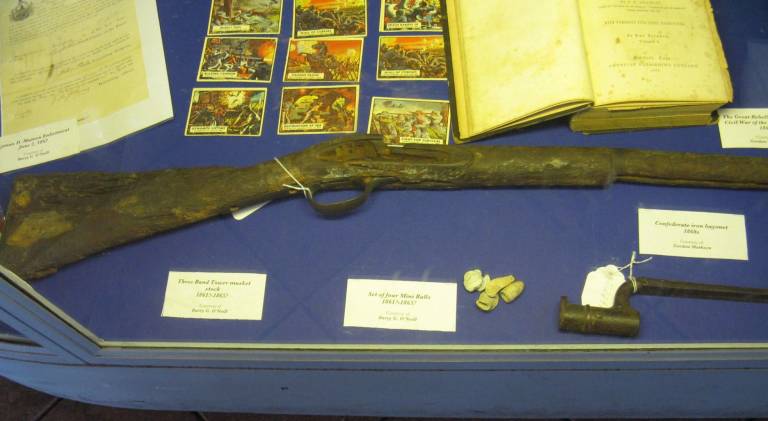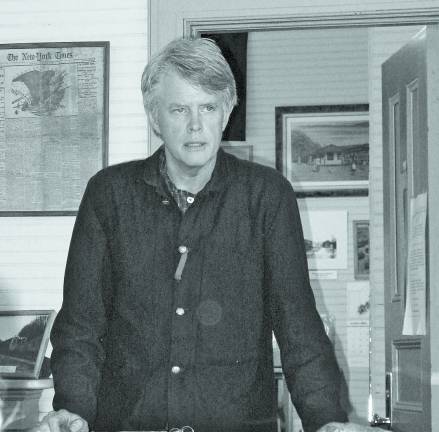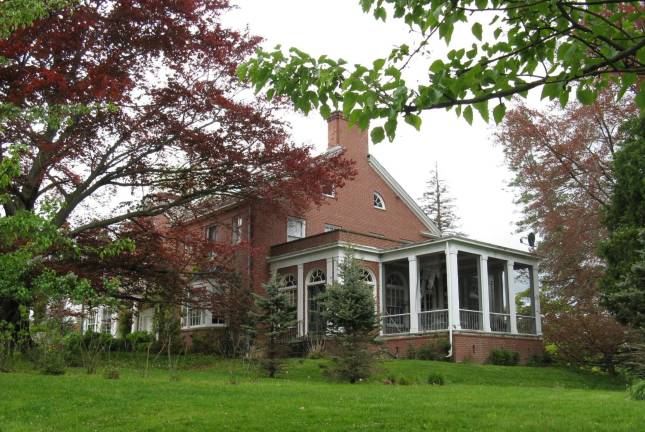Union and disunion



By Ginny Privitar CHESTER Civil War re-enactor Jim Meaney, dressed in a reproduction uniform adorned with an Orange Blossoms ribbon, showed what a typical soldier of the day would have carried: a musket, knapsack, eating utensils, bedroll and more.
At the Erie Station Museum's opening last Saturday, visitors got to see artifacts that tell the story of the war from a personal perspective. On exhibit are a musket and bayonet, some infamous mini-ball bullets, regimental honor rolls and photographs, Grand Army of the Republic reunion ribbons, and modern prints. A letter on loan from Village of Chester Historian Lorraine Hom, from her ancestor George Smith (3rd Regiment, NYS Calvary) to his sister Mrs. C.L. Potter, described his delight with the uniform items he was issued.
Meaney said the original Orange Blossoms, the 124th New York State Volunteers, formed in Orange County in 1862, fought in many of the war's best-known battles. Its original commander, Col. Augustus Van Horne Ellis, is honored with a statue at Gettysburg. Many letters survive from the 124th, particularly from brothers William and Henry Howell of Middletown, which provide re-enactors with valuable information about the soldier's daily life and concerns.
Visitors to the exhibit, sponsored by the Chester Historical Society, also heard Jeff Albanese, a member of the Sons of the Union Veterans, talk about his own ancestors history and New Yorkers' many contributions to the war. He highlighted two contemporaries who had homes in Goshen and are buried in Goshens Slate Hill Cemetery, which contains many veterans graves.
Goshen lawyer tries Lincoln's assassins
Albanese introduced the audience to Brevet Brigadier General Henry Lawrence Burnett, a lawyer who was appointed judge advocate for the Union Army and worked on many important trials, including one involving the Knights of the Golden Circle, a group of southerners who worked behind the Union lines. Two days after Lincolns assassination, he was summoned to Washington by Edward Stanton, Secretary of War, who appointed him an assistant advocate general, one of the four-member military tribunal that presided over the trial of the Lincoln assassination conspirators. Burnetts job was to obtain the evidence in the trial.
Burnett married three times and outlived two of his wives. At the time of his third marriage, he was living in New York City. He had an interest in horse racing and bought a house in Goshen, where he lived during the racing season. (The house still exists, and was occupied at various times by members of the Westinghouse family and the Gabor sisters.) Burnett was a member of the Goshen Driving Club and raced at the track. He died in New York City in 1916 and was buried in Slate Hill Cemetery. His monument is quite impressive, but is missing its original bronze plaque.
Later Albanese introduced Anna Dickinson, an abolitionist who lived for 41 years in the building that now houses Lindas Office Supplies and Joe Fix It's. She was one of the most famous speakers in her day, and the first woman invited to speak before Congress. When she was 13 she wrote an article about the evils of slavery that appeared in The Liberator, published by abolitionist William Lloyd Garrison. She was an excellent orator who also spoke in favor of womens rights. In her heyday, she made as much as $20,000 a year. She was also a critic of Lincoln, whom she felt wasnt doing enough to end slavery.
A print of the painting by Dan Troiani, The Men Must See Us Today," hangs on the wall in the station museum. It depicts a moment in the Battle of Gettysburg, Meaney explained. The 124th was the last regiment on the far left of the union line at Devils Den. That day, in the chaos of war, they fought four different Confederate regiments. The second in command, Maj. James Cromwell, is credited with saying The men must see us today.
The commanding officers were on horseback to make themselves highly visible to rally the men. Cromwell was killed, as was Col. Ellis. The third in command, Lt. Col Francis Cummins, was wounded. Command fell to Charles Weygant, who a year before was running his familys livery business.
For a glimpse into the past, and to learn more about the Civil War, visit the Chester Historical Societys Erie Station Museum any Saturday from 9 a.m. to 1 p.m. through October.